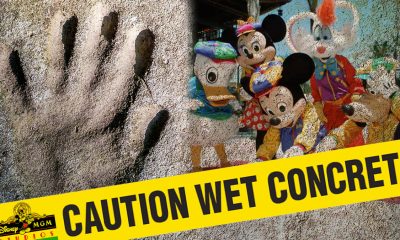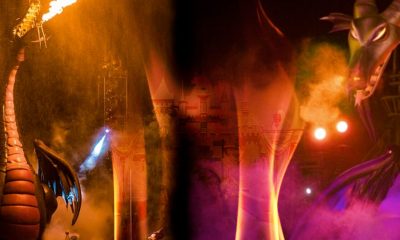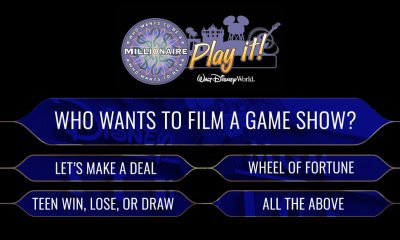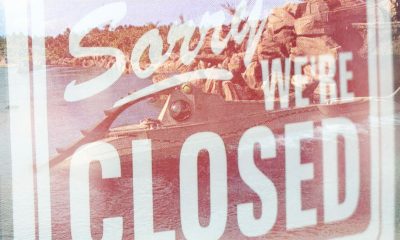Theme Parks & Themed Entertainment
Why “Western River” Went South — Part 7
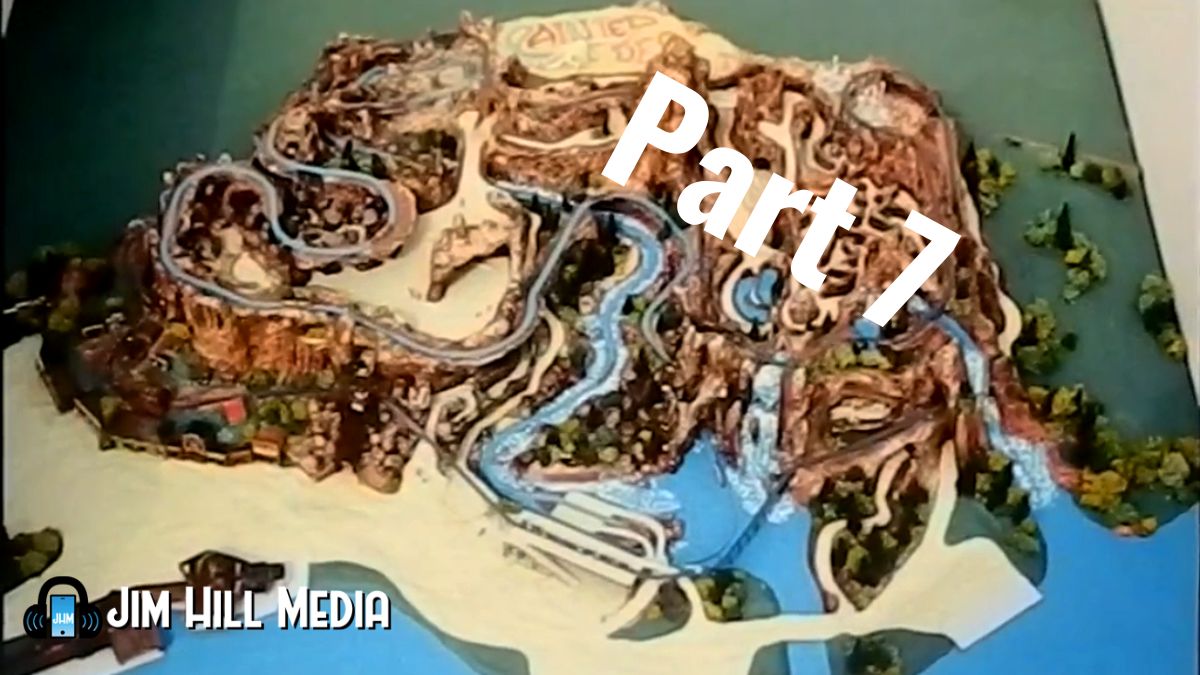
OUR STORY SO FAR: 75 years of films, TV shows and videos have taught us that all Disney stories end happily, right?
Well, not this time, kiddies.
After five years of hard work and planning, Marc Davis watched as his dream project – “Western River Expedition,” an audio animatronic extravaganza that could have been the best thing WED ever did – slowly fell from favor.
But what could Marc do? Times had changed. Where once Disney theme park guests had gone gaga over elaborately themed attractions like “Pirates of the Caribbean,” now the big draws at the park were sleek thrill rides like “Space Mountain.”
So – in spite of the fact that its construction site had already been cleared and that his proposed attraction had been heavily hyped as “Coming Soon” to WDW’s Magic Kingdom – Davis had to face facts. “Western River Expedition” wasn’t going to happen. At least not in Florida.
But was there a chance that his dream attraction might find a home elsewhere? Like – say – that other Disney theme park in California?
For a while there, it really did seem possible.
Things just don’t get much more ironic than this.
“The Walt Disney Story” opens at WDW’s Magic Kingdom in April 1973. As part of the post-show area of this attraction, the Imagineers spent several thousand dollars to create an elaborate exhibit that proclaimed “Western River Expedition” as the next big thing for the Florida resort.
Meanwhile, back at corporate headquarters in Burbank, Disney Chairman Card Walker was trying to save the company several million dollars by canceling the attraction altogether.
But what could Card do? For five years now, the Mouse had been saying that “Western River Expedition” (“WRE”) would be “Coming Soon” to Walt Disney World. As a result, the proposed ride had a lot of folks – both inside and outside of the company – who eagerly awaiting the arrival of the attraction. These people wouldn’t be too pleased if Disney didn’t deliver after all those years of hype.
The gas crisis had bought Card a little time. Then the emergence of Tony Baxter’s plans for “Big Thunder Mountain Railway” had given Walker an affordable alternative attraction to build in WDW’s Frontierland.
But what about “Western River Expedition”? Did Walker dare to just cancel the project outright? Given that Roy Disney himself had put “WRE” into development, that didn’t seem like the politically savvy thing to do.
Plus – given that Marc Davis was considered to be a genius by many at WED – pulling the plug on this proposed attraction was almost sure to cause an uproar at Imagineering.
Card couldn’t afford to get into a war with WED in late 1973 / early 1974. Walker needed to keep all of his Imagineers happy so that they help him figure out how to pull off Epcot. (Back then, Card didn’t have a clue as to how to go about building Walt’s future city.)
So Walker did what most every good corporate leader does when faced with a tough situation: Rather than do something that might potentially come back and bite him in the ass, Card made a decision not to decide. So the WDW’s “Western River Expedition” attraction were never officially canceled. Plans for the proposed ride were just put on hold. Permanently.
Marc Davis found this situation absolutely maddening. He wasn’t going to allow five years of work just to be swept under the rug by some cute corporate maneuvering by Card. So Davis did whatever he had to, to keep “Western River” alive.
The first thing Davis did was sell the folks in charge of Disneyland on the idea that “WRE” might make a nice addition to the Anaheim park. Marc must have done a pretty good job – for, in the December 1974 issue of “Backstage” magazine (A quarterly publication produced *BY* Disneyland cast members *FOR* Disneyland cast members) – there’s an article that lists the many different attractions that were then under consideration for construction in “The Happiest Place on Earth.”
Among these attractions was:
* “Space Mountain” – an Anaheim version of the then-still-under-construction WDW thrill ride.
* “Mission to Mars” – a redo of Disneyland’s “Flight to the Moon” attraction.
* “Pinocchio’s Village” – a proposed expansion of Fantasyland, which would feature a new dark ride as well as a new restaurant location.
* “Liberty Square” – which would have included WDW’s “Hall of Presidents.”
* “The UFO Show” – which would have been staged upstairs over “America Sings.” Aired with air guns, guests would have boarded cars and tried to shoot “eerie, un-human, gremlin-like targets.”
(Sound like any modern day WDW Tomorrowland attractions you know? That’s right. “Buzz Lightyear’s Space Ranger Spin.” It only took 25 years, but this unusual attraction idea did finally make it off the drawing board.)
* “Western River Expedition” – Just like the version that had been originally been proposed for construction in Frontierland at WDW’s Magic Kingdom. In Anaheim, “WRE” was being viewed as a possible replacement for the “Mine Trains through Nature’s Wonderland” ride.
Unfortunately for Marc, WED also had another candidate for that valuable piece of Disneyland real estate. Which ride was this? You guess it, kids.
Tony Baxter’s “Big Thunder Mountain Railway.”
It’s important to note here that Disneyland management didn’t do this just to humor Marc Davis. They must have seriously considered adding “Western River Expedition” to the Anaheim park. For a few years in the mid-1970s, the “Disneyland Showcase” preview center actually featured a “WRE” model as well as some of Marc’s concept paintings.
But – if Card wasn’t willing to spend the money to build “Western River” in Orlando – what made Marc think that Walker would ever cough up the cash to build the same show in Anaheim? Why make all this effort when it was obvious that “WRE” wasn’t ever going to happen while Card was calling the shots?
No one – outside of Marc himself – knew what drove Davis to be so dogged about “Western River.” A lot of the older Imagineers admired Marc for his determination. (However, it should also be noted that some of the younger folks at WED thought Davis’ endless attempts to get “WRE” built verged on ridiculous.)
Mind you, Marc didn’t spend all of his time between 1974 – 1978 just trying to get Disneyland’s version of “Western River Expedition” off the ground. He also worked up a new show for that park’s “Carousel of Progress” theater: “America Sings.”
This audio animatronic tribute to American popular song opened in June 1974. Intended to be the signature attraction for Disneyland’s Bicentennial celebration, Marc really pulled out the stops with “America Sings” – designing over a hundred new AA figures for the show. Thanks to Marc’s intimate knowledge of what Disney’s robotic figures were capable of, Davis had his “AS” characters do things no AA figures had ever done before: dance, strum electric guitars, even walk upstairs.
Marc also worked up plans for a wonderful new ride-through attraction for Disneyland’s Fantasyland: “The Enchanted Snow Palace.” Riding in boats similar to those featured in “it’s a small world,” guests would have taken a cool but colorful trip through a winter wonderland. As music from Tchaikovsky’s “The Nutcracker Suite” echoed through the glacier- shaped show building, guests would have glimpsed lovely snow fairies, encountered horrible ice giants as well as made a trip through the chilly chambers of the Snow Queen.
Davis also worked up concepts for a new set of AA animal sequences to be added to Disneyland’s “Mine Trains through Nature’s Wonderland” … until he learned that Disneyland had decided to close Anaheim’s mine trains to make way for Tony Baxter’s “Big Thunder Mountain Railway.”
Not “Western River,” mind you. But “Big Thunder Mountain.”
Marc was doubly disappointed when he learned that Walker had just cut a deal with the Oriental Land Company to build another Disneyland. Davis knew that the Japanese were just wild about the American west. So he proposed to WED management that they show his “Western River Expedition” plans to the Japanese businessmen who were funding the Tokyo Bay project.
What Marc heard next broke his heart.
“Actually, what the Oriental Land guys would prefer is ‘Pirates of the Caribbean.’ But they don’t want a special Japanese version. They say they just want an exact duplicate of the Disneyland ride.”
Not a new ride. Not even an improved version of an old ride. But an exact duplicate of Disneyland’s then 11 year old “Pirates of the Caribbean” ride.
Marc had had enough. For 10 years, he’d been trying to get WED and Disney Productions management to take on “Western River Expedition,” a project that would have challenged the Imagineers to do their best work ever.
The Mouse wasn’t interested in attractions like that. Back then, all they wanted was affordable new thrill rides for the park and / or faithful recreations of decade old attractions.
Rather than keeping fighting, Davis packed it in in 1978. Since being an Imagineer just wasn’t much fun anymore, Marc retired from WED and went home.
All his wonderful concept drawings for “Western River Expedition” were filed away in the Imagineering Research Library. All the miniature Thunder Mesas were stashed on the back shelves of WED’s model shop. Even the “WRE” model in the post-show area of WDW’s “Walt Disney Story” was hidden away from sight.
And that should have been the end of “Western River Expedition.”
But it wasn’t …
History
The Evolution and History of Mickey’s ToonTown

Disneyland in Anaheim, California, holds a special place in the hearts of Disney fans worldwide, I mean heck, it’s where the magic began after all. Over the years it’s become a place that people visit in search of memorable experiences. One fan favorite area of the park is Mickey’s Toontown, a unique land that lets guests step right into the colorful, “Toony” world of Disney animation. With the recent reimagining of the land and the introduction of Micky and Minnies Runaway Railway, have you ever wondered how this land came to be?
There is a fascinating backstory of how Mickey’s Toontown came into existence. It’s a tale of strategic vision, the influence of Disney executives, and a commitment to meeting the needs of Disney’s valued guests.
The Beginning: Mickey’s Birthdayland
The story of Mickey’s Toontown starts with Mickey’s Birthdayland at Walt Disney World’s Magic Kingdom. Opened in 1988 to celebrate Mickey Mouse’s 60th birthday, this temporary attraction was met with such overwhelming popularity that it inspired Disney executives to think bigger. The idea was to create a permanent, immersive land where guests could step into the animated world of Mickey Mouse and his friends.
In the early ’90s, Disneyland was in need of a refresh. Michael Eisner, the visionary leader of The Walt Disney Company at the time, had an audacious idea: create a brand-new land in Disneyland that would celebrate Disney characters in a whole new way. This was the birth of Mickey’s Toontown.
Initially, Disney’s creative minds toyed with various concepts, including the idea of crafting a 100-Acre Woods or a land inspired by the Muppets. However, the turning point came when they considered the success of “Who Framed Roger Rabbit.” This film’s popularity and the desire to capitalize on contemporary trends set the stage for Toontown’s creation.
From Concept to Reality: The Birth of Toontown
In 1993, Mickey’s Toontown opened its gates at Disneyland, marking the first time in Disney Park history where guests could experience a fully realized, three-dimensional world of animation. This new land was not just a collection of attractions but a living, breathing community where Disney characters “lived,” worked, and played.
Building Challenges: Innovative Solutions
The design of Mickey’s Toontown broke new ground in theme park aesthetics. Imagineers were tasked with bringing the two-dimensional world of cartoons into a three-dimensional space. This led to the creation of over 2000 custom-built props and structures that embodied the ‘squash and stretch’ principle of animation, giving Toontown its distinctiveness.
And then there was also the challenge of hiding the Team Disney Anaheim building, which bore a striking resemblance to a giant hotdog. The Imagineers had to think creatively, using balloon tests and imaginative landscaping to seamlessly integrate Toontown into the larger park.

Key Attractions: Bringing Animation to Life
Mickey’s Toontown featured several groundbreaking attractions. “Roger Rabbit’s Car Toon Spin,” inspired by the movie “Who Framed Roger Rabbit,” became a staple of Toontown, offering an innovative ride experience. Gadget’s Go-Coaster, though initially conceived as a Rescue Rangers-themed ride, became a hit with younger visitors, proving that innovative design could create memorable experiences for all ages.
Another crown jewel of Toontown is Mickey’s House, a walkthrough attraction that allowed guests to explore the home of Mickey Mouse himself. This attraction was more than just a house; it was a carefully crafted piece of Disney lore. The house was designed in the American Craftsman style, reflecting the era when Mickey would have theoretically purchased his first home in Hollywood. The attention to detail was meticulous, with over 2000 hand-crafted, custom-built props, ensuring that every corner of the house was brimming with character and charm. Interestingly, the design of Mickey’s House was inspired by a real home in Wichita Falls, making it a unique blend of real-world inspiration and Disney magic.
Mickey’s House also showcased Disney’s commitment to creating interactive and engaging experiences. Guests could make themselves at home, sitting in Mickey’s chair, listening to the radio, and exploring the many mementos and references to Mickey’s animated adventures throughout the years. This approach to attraction design – where storytelling and interactivity merged seamlessly – was a defining characteristic of ToonTown’s success.

Executive Decisions: Shaping ToonTown’s Unique Attractions
The development of Mickey’s Toontown wasn’t just about creative imagination; it was significantly influenced by strategic decisions from Disney executives. One notable input came from Jeffrey Katzenberg, who suggested incorporating a Rescue Rangers-themed ride. This idea was a reflection of the broader Disney strategy to integrate popular contemporary characters and themes into the park, ensuring that the attractions remained relevant and engaging for visitors.
In addition to Katzenberg’s influence, Frank Wells, the then-President of The Walt Disney Company, played a key role in the strategic launch of Toontown’s attractions. His decision to delay the opening of “Roger Rabbit’s Car Toon Spin” until a year after Toontown’s debut was a calculated move. It was designed to maintain public interest in the park by offering new experiences over time, thereby giving guests more reasons to return to Disneyland.
These executive decisions highlight the careful planning and foresight that went into making Toontown a dynamic and continuously appealing part of Disneyland. By integrating current trends and strategically planning the rollout of attractions, Disney executives ensured that Toontown would not only capture the hearts of visitors upon its opening but would continue to draw them back for new experiences in the years to follow.
Global Influence: Toontown’s Worldwide Appeal
The concept of Mickey’s Toontown resonated so strongly that it was replicated at Tokyo Disneyland and influenced elements in Disneyland Paris and Hong Kong Disneyland. Each park’s version of Toontown maintained the core essence of the original while adapting to its cultural and logistical environment.
Evolution and Reimagining: Toontown Today
As we approach the present day, Mickey’s Toontown has recently undergone a significant reimagining to welcome “Mickey & Minnie’s Runaway Railway” in 2023. This refurbishment aimed to enhance the land’s interactivity and appeal to a new generation of Disney fans, all while retaining the charm that has made ToonTown a beloved destination for nearly three decades.

Dive Deeper into ToonTown’s Story
Want to know more about Mickey’s Toontown and hear some fascinating behind-the-scenes stories, then check out the latest episode of Disney Unpacked on Patreon @JimHillMedia. In this episode, the main Imagineer who worked on the Toontown project shares lots of interesting stories and details that you can’t find anywhere else. It’s full of great information and fun facts, so be sure to give it a listen!
History
Unpacking the History of the Pixar Place Hotel

Pixar Place Hotel, the newly unveiled 15-story tower at the Disneyland Resort, has been making waves in the Disney community. With its unique Pixar-themed design, it promises to be a favorite among visitors.
However, before we delve into this exciting addition to the Disneyland Resort, let’s take a look at the fascinating history of this remarkable hotel.
The Emergence of the Disneyland Hotel
To truly appreciate the story of the Pixar Place Hotel, we must turn back the clock to the early days of Disneyland. While Walt Disney had the visionary ideas and funding to create the iconic theme park, he faced a challenge when it came to providing accommodations for the park’s visitors. This is where his friend Jack Wrather enters the picture.
Jack Wrather, a fellow pioneer in the television industry, stepped in to assist Walt Disney in realizing his dream. Thanks to the success of the “Lassie” TV show produced by Wrather’s company, he had the financial means to build a hotel right across from Disneyland.
The result was the Disneyland Hotel, which opened its doors in October 1955. Interestingly, the early incarnation of this hotel had more of a motel feel than a hotel, with two-story buildings reminiscent of the roadside motels popular during the 1950s. The initial Disneyland Hotel consisted of modest structures that catered to visitors looking for affordable lodging close to the park. While the rooms were basic, it marked the beginning of something extraordinary.
The Evolution: From Emerald of Anaheim to Paradise Pier
As Disneyland’s popularity continued to soar, so did the demand for expansion and improved accommodations. In 1962, the addition of an 11-story tower transformed the Disneyland Hotel, marking a significant transition from a motel to a full-fledged hotel.
The addition of the 11-story tower elevated the Disneyland Hotel into a more prominent presence on the Anaheim skyline. At the time, it was the tallest structure in all of Orange County. The hotel’s prime location across from Disneyland made it an ideal choice for visitors. With the introduction of the monorail linking the park and the hotel, accessibility became even more convenient. Unique features like the Japanese-themed reflecting pools added to the hotel’s charm, reflecting a cultural influence that extended beyond Disney’s borders.
Japanese Tourism and Its Impact
During the 1960s and 1970s, Disneyland was attracting visitors from all corners of the world, including Japan. A significant number of Japanese tourists flocked to Anaheim to experience Walt Disney’s creation. To cater to this growing market, it wasn’t just the Disneyland Hotel that aimed to capture the attention of Japanese tourists. The Japanese Village in Buena Park, inspired by a similar attraction in Nara, Japan, was another significant spot.
These attractions sought to provide a taste of Japanese culture and hospitality, showcasing elements like tea ceremonies and beautiful ponds with rare carp and black swans. However, the Japanese Village closed its doors in 1975, likely due to the highly competitive nature of the Southern California tourist market.
The Emergence of the Emerald of Anaheim
With the surge in Japanese tourism, an opportunity arose—the construction of the Emerald of Anaheim, later known as the Disneyland Pacific Hotel. In May 1984, this 15-story hotel opened its doors.
What made the Emerald unique was its ownership. It was built not by The Walt Disney Company or the Oriental Land Company (which operated Tokyo Disneyland) but by the Tokyu Group. This group of Japanese businessmen already had a pair of hotels in Hawaii and saw potential in Anaheim’s proximity to Disneyland. Thus, they decided to embark on this new venture, specifically designed to cater to Japanese tourists looking to experience Southern California.
Financial Challenges and a Changing Landscape
The late 1980s brought about two significant financial crises in Japan—the crash of the NIKKEI stock market and the collapse of the Japanese real estate market. These crises had far-reaching effects, causing Japanese tourists to postpone or cancel their trips to the United States. As a result, reservations at the Emerald of Anaheim dwindled.
To adapt to these challenging times, the Tokyu Group merged the Emerald brand with its Pacific hotel chain, attempting to weather the storm. However, the financial turmoil took its toll on the Emerald, and changes were imminent.
The Transition to the Disneyland Pacific Hotel
In 1995, The Walt Disney Company took a significant step by purchasing the hotel formerly known as the Emerald of Anaheim for $35 million. This acquisition marked a change in the hotel’s fortunes. With Disney now in control, the hotel underwent a name change, becoming the Disneyland Pacific Hotel.
Transformation to Paradise Pier
The next phase of transformation occurred when Disney decided to rebrand the hotel as Paradise Pier Hotel. This decision aligned with Disney’s broader vision for the Disneyland Resort.
While the structural changes were limited, the hotel underwent a significant cosmetic makeover. Its exterior was painted to complement the color scheme of Paradise Pier, and wave-shaped crenellations adorned the rooftop, creating an illusion of seaside charm. This transformation was Disney’s attempt to seamlessly integrate the hotel into the Paradise Pier theme of Disney’s California Adventure Park.
Looking Beyond Paradise Pier: The Shift to Pixar Place
In 2018, Disneyland Resort rebranded Paradise Pier as Pixar Pier, a thematic area dedicated to celebrating the beloved characters and stories from Pixar Animation Studios. As a part of this transition, it became evident that the hotel formally known as the Disneyland Pacific Hotel could no longer maintain its Paradise Pier theme.
With Pixar Pier in full swing and two successful Pixar-themed hotels (Toy Story Hotels in Shanghai Disneyland and Tokyo Disneyland), Disney decided to embark on a new venture—a hotel that would celebrate the vast world of Pixar. The result is Pixar Place Hotel, a 15-story tower that embraces the characters and stories from multiple Pixar movies and shorts. This fully Pixar-themed hotel is a first of its kind in the United States.
The Future of Pixar Place and Disneyland Resort
As we look ahead to the future, the Disneyland Resort continues to evolve. The recent news of a proposed $1.9 billion expansion as part of the Disneyland Forward project indicates that the area surrounding Pixar Place is expected to see further changes. Disneyland’s rich history and innovative spirit continue to shape its destiny.
In conclusion, the history of the Pixar Place Hotel is a testament to the ever-changing landscape of Disneyland Resort. From its humble beginnings as the Disneyland Hotel to its transformation into the fully Pixar-themed Pixar Place Hotel, this establishment has undergone several iterations. As Disneyland Resort continues to grow and adapt, we can only imagine what exciting developments lie ahead for this iconic destination.
If you want to hear more stories about the History of the Pixar Place hotel, check our special edition of Disney Unpacked over on YouTube.
Stay tuned for more updates and developments as we continue to explore the fascinating world of Disney, one story at a time.
History
From Birthday Wishes to Toontown Dreams: How Toontown Came to Be

In the latest release of Episode 4 of Disney Unpacked, Len and I return, joined as always by Disney Imagineering legend, Jim Shull. This two-part episode covers all things Mickey’s Birthday Land and how it ultimately led to the inspiration behind Disneyland’s fan-favorite land, “Toontown”. But let’s not get ahead of ourselves here. It all starts in the early days at Disneyland.
Early Challenges in Meeting Mickey
Picture this: it’s the late 1970s and early 1980s, and you’re at Disneyland. You want to meet the one and only Mickey Mouse, but there’s no clear way to make it happen. You rely on Character Guides, those daily printed sheets that point you in Mickey’s general direction. But let’s be honest, it was like finding a needle in a haystack. Sometimes, you got lucky; other times, not so much.

Mickey’s Birthdayland: A Birthday Wish that Came True
Fast forward to the late 1980s. Disney World faced a big challenge. The Disney-MGM Studios Theme Park was under construction, with the company’s marketing machine in full swing, hyping up the opening of Walt Disney World’s third theme park, MGM Studios, in the Spring of 1989. This extensive marketing meant that many people were opting to postpone their family’s next trip to Walt Disney World until the following year. Walt Disney World needed something compelling to motivate guests to visit Florida in 1988, the year before Disney MGM Studios opened.
Enter stage left, Mickey’s Birthdayland. For the first time ever, an entire land was dedicated to a single character – and not just any character, but the mouse who started it all. Meeting Mickey was no longer a game of chance; it was practically guaranteed.

The Birth of Birthdayland: Creative Brilliance Meets Practicality
In this episode, we dissect the birth of Mickey’s Birthdayland, an initiative that went beyond celebrating a birthday. It was a calculated move, driven by guest feedback and a need to address issues dating back to 1971. Imagineers faced the monumental task of designing an experience that honored Mickey while efficiently managing the crowds. This required the perfect blend of creative flair and logistical prowess – a hallmark of Disney’s approach to theme park design.
Evolution: From Birthdayland to Toontown
The success of Mickey’s Birthdayland was a real game-changer, setting the stage for the birth of Toontown – an entire land that elevated character-centric areas to monumental new heights. Toontown wasn’t merely a spot to meet characters; it was an immersive experience that brought Disney animation to life. In the episode, we explore its innovative designs, playful architecture, and how every nook and cranny tells a story.

Impact on Disney Parks and Guests
Mickey’s Birthdayland and Toontown didn’t just reshape the physical landscape of Disney parks; they transformed the very essence of the guest experience. These lands introduced groundbreaking ways for visitors to connect with their beloved characters, making their Disney vacations even more unforgettable.
Beyond Attractions: A Cultural Influence
But the influence of these lands goes beyond mere attractions. Our episode delves into how Mickey’s Birthdayland and Toontown left an indelible mark on Disney’s culture, reflecting the company’s relentless dedication to innovation and guest satisfaction. It’s a journey into how a single idea can grow into a cherished cornerstone of the Disney Park experience.

Unwrapping the Full Story of Mickey’s Birthdayland
Our two-part episode of Disney Unpacked is available for your viewing pleasure on our Patreon page. And for those seeking a quicker Disney fix, we’ve got a condensed version waiting for you on our YouTube channel. Thank you for being a part of our Disney Unpacked community. Stay tuned for more episodes as we continue to “Unpack” the fascinating world of Disney, one story at a time.
-

 News & Press Releases11 months ago
News & Press Releases11 months agoDisney Will Bring D23: The Ultimate Disney Fan Event to Anaheim, California in August 2024
-

 History6 months ago
History6 months agoFrom Birthday Wishes to Toontown Dreams: How Toontown Came to Be
-

 History6 months ago
History6 months agoUnpacking the History of the Pixar Place Hotel
-

 History6 months ago
History6 months agoThe Evolution and History of Mickey’s ToonTown
-

 News & Press Releases5 months ago
News & Press Releases5 months agoNew Updates and Exclusive Content from Jim Hill Media: Disney, Universal, and More
-

 Film & Movies3 months ago
Film & Movies3 months agoHow Disney’s “Bambi” led to the creation of Smokey Bear
-

 Merchandise4 months ago
Merchandise4 months agoIntroducing “I Want That Too” – The Ultimate Disney Merchandise Podcast



